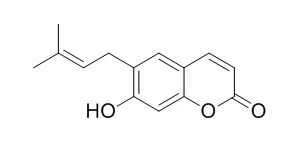| In vitro: |
| Arch Pharm Res. 2016 Feb;39(2):231-9. | | Constituents of PG201 (Layla(®)), a multi-component phytopharmaceutical, with inhibitory activity on LPS-induced nitric oxide and prostaglandin E2 productions in macrophages.[Pubmed: 26306655] | Fourteen compounds, coumarin (1), Demethylsuberosin (2), xanthotoxin (3), psoralen (4), decursinol (5), decursin (6), decursinol angelate (7), chikusetsusaponin IVa (8), chikusetsusaponin IVa methyl ester (9), ethyl caffeate (10), syringaresinol (11), cnidilide (12), farnesol (13), and linoleic acid (14), were isolated from phytopharmaceutical PG201 (Layla(®)) by activity-guided fractionation utilizing inhibitory activity on nitric oxide (NO) production in vitro.
METHODS AND RESULTS:
The isolates 1-14 were evaluated for their inhibitory activity on LPS-induced NO and prostaglandin E2 (PGE2) productions in RAW 264.7 cells. All the compounds except 14 displayed suppressive effects on LPS-induced NO and PGE2 production with IC50 values ranging from 8 to 60 μM. Among these, compound 10 showed the most potent inhibitory effect on NO production from RAW 264.7 cells with an IC50 value of 8.25 μM. Compounds 2, 9, and 10 exhibited high inhibitory effects on PGE2 production with the IC50 values of 9.42, 7.51, and 6.49 μM, respectively.
CONCLUSIONS:
These findings suggest that compounds 2, 9, and 10 are the potential anti-inflammatory active constituents of PG201 and further study may be needed to explain their mechanism of action. | | J Nat Prod. 2011 Oct 28;74(10):2286-9. | | Structure and in vitro antiparasitic activity of constituents of Citropsis articulata root bark.[Pubmed: 21985060] | From the results of an ethnomedicinal investigation of plants from Uganda with antimalarial activity, Citropsis articulata was selected because of the antiplasmodial effect of an ethyl acetate extract of its root bark.
METHODS AND RESULTS:
Thus, from the cyclohexane, ethyl acetate, and methanol extracts, two new heterocyclic compounds, omubioside (1) and katimborine (2), were isolated in addition to five known coumarins (rutarin (3), seselin (4), suberosin (5), Demethylsuberosin (6), and haploperoside (7)), two known alkaloids (5-hydroxynoracronycine (8) and 1,5-dihydroxy-2,3-dimethoxy-10-methyl-9-acridone (9)), trigonelline (10), and the limonoid 7α-obacunyl acetate (11).
CONCLUSIONS:
The best growth inhibitors of Plasmodium falciparum were alkaloids 8 and 9, with IC50 values of 0.9 and 3.0 μg/mL. |
|






 Cell. 2018 Jan 11;172(1-2):249-261.e12. doi: 10.1016/j.cell.2017.12.019.IF=36.216(2019)
Cell. 2018 Jan 11;172(1-2):249-261.e12. doi: 10.1016/j.cell.2017.12.019.IF=36.216(2019) Cell Metab. 2020 Mar 3;31(3):534-548.e5. doi: 10.1016/j.cmet.2020.01.002.IF=22.415(2019)
Cell Metab. 2020 Mar 3;31(3):534-548.e5. doi: 10.1016/j.cmet.2020.01.002.IF=22.415(2019) Mol Cell. 2017 Nov 16;68(4):673-685.e6. doi: 10.1016/j.molcel.2017.10.022.IF=14.548(2019)
Mol Cell. 2017 Nov 16;68(4):673-685.e6. doi: 10.1016/j.molcel.2017.10.022.IF=14.548(2019)